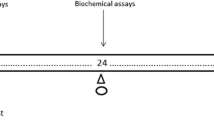Abstract
Following eight monthly haloperidol decanoate injections rats showed an increased rate of vacuous chewing movements (VCM's), which gradually disappeared within 4 drug-free months. Another single dose of non-decanoate haloperidol reinstated a second increase in VCM rate which was still significant after 2 months. The glutamic acid decarboxylase (GAD) activity in the substantia nigra of these chronically haloperidol-treated rats was lower than untreated controls. Furthermore, there was a significant negative correlation between individual VCM rates and nigral GAD activity. No corresponding changes occurred in other brain regions. The depression of nigral GAD may reflect a reduced tissue density of GABA-ergic axon terminals within the descending striato-nigral pathway.
Similar content being viewed by others
References
Barany S, Ingvast A, Gunne LM (1979) Development of acute dystonia and tardive dyskinesia in Cebus monkeys. Res Commun Chem Pathol Pharmacol 25:269–279
Bird ED, Iversen LL (1974) Huntington's chorea. Post mortem measurement of glutamic acid decarboxylase, choline acetyltransferase and dopamine in basal ganglia. Brain 97:457–472
Carlsson A (1970) Biochemical implications of dopa-induced actions on the central nervous system with particular relevance to abnormal movements. In: Barbeau A, McDowell FH (eds) L-Dopa and parkinsonism. Davis, Philadelphia, pp 205–213
Gale K (1980) Chronic blockade of dopamine receptors by antischizophrenic drugs enhances GABA binding in substatia nigra. Nature 283:569–570
Gale K, Casu M (1981) Dynamic utilization of GABA in substantia nigra: regulation by dopamine and GABA in the striatum, and its clinical and behavioral implications. Mol Cell Biochem 39:369–405
Glassman RB, Glassman HN (1980) Oral dyskinesia in brain-damaged rats withdrawn from a neuroleptic: implication for models of tardive dyskinesia. Psychopharmacology 69:19–25
Gunne LM, Growdon J, Glaeser B (1982) Oral dyskinesia in rats following brain lesions and neuroleptic drug administration. Psychopharmacology 77:134–139
Häggström JE, Andersson U, Gunne LM (1981) A primate model for tardive dyskinesia. Post mortem biochemical findings. In: Perris C, Struwe G, Jansson B (eds) Developments in psychiatry, vol 5, Biological psychiatry. Elsevier/North Holland, Biomedical Press, Amsterdam, pp 837–839
Itoh M (1983) Effect of haloperidol on glutamine decarboxylase activity in discrete brain areas of the rat. Psychopharmacology 79:169–172
Itoh M, Uchimura H (1981) Regional differences in cofactor saturation of glutamate decarboxylase in discrete brain nuclei of the rat. Neurochem Res 6:1277–1283
Javoy-Agid F, Ploska A, Agid Y (1981) Microtopography of tyrosine hydroxylase, glutamic acid decarboxylase, and choline acetyltransferase in the substantia nigra and ventral tegmental area of control and parkinsonian brains. J Neurochem 37:1218–1227
Kirk RE (1968) Experimental design: Procedures for the behavioral sciences Brooks/Cole Publishing Company, Belmont, California
Klawans Jr HL (1973) The pharmacology or tardive dyskinesia. Am J Psychiatry 130:82–86
Lloyd KG, Hornykiewicz O (1977) Effect of chronic neuroleptic or L-dopa administration on GABA levels in the rat substantia nigra. Life Sci 21:1489–1496
Lloyd KG, Möhler H, Heitz PH, Bartholini G (1975) Distribution of choline acetyltransferase and glutamate decarboxylase within the substantia nigra and in other brain regions from control and Parkinsonian patients. J Neurochem 25:789–795
McGeer PL, McGeer EG (1976) The GABA system and function of the basal ganglia: Huntington's Disease. In: Roberts E, Chase TN, Tower DB (eds) GABA in nervous system function. Raven Press, New York, pp 487–495
Mao CC, Cheney DL, Marco E, Revuelta A, Costa E (1977) Turnover times of gamma-butyric acid and acetylcholine in nucleus caudatus, nucleus accumbens, globus pallidus and substantia nigra: effects of repeated administration of haloperidol. Brain Res 132:375–379
Mao C, Costa E (1978) Biochemical pharmacology of GABA transmission. In: Lipton MA, DiMascio A, Killam KF (eds) Psychopharmacology: A generation of progress. Raven Press, New York, pp 307–318
Ribak CE, Vaughn JE, Roberts E (1979) The GABA neurons and their axon terminals in rat corpus striatum as demonstrated by GAD immunocytochemistry. J Comp Neurol 187:261–274
Rinne UK, Laaksonen H, Riekkinen P, Sonninen V (1974) Brain glutamic acid decarboxylase activity in Parkinson's disease. Eur Neurol 12:13–19
Scatton B, Worms P, Lloyd KG, Bartholini G (1982) Cortical modulation of striatal function. Brain Res 232:331–343
Scheel-Krüger J, Magelund G, Olianas MC (1981) Role of GABA in the striatal output system: globus pallidus, nucleus entopeduncularis, substantia nigra and nucleus subthalamicus. In: DiChiara G, Gessa GL (eds) GABA and the basal ganglia. Raven Press, New York, pp 165–186
Tarsy D, Baldessarini RJ (1977) The pathophysiologic basis of tardive dyskinesia. Biol Psychiatry 12:431–450
Urquhart N, Perry TL, Hansen S, Kennedy J (1975) GABA content and glutamic acid decarboxylase activity in brain of Huntington's chorea patients and control subjects. J Neurochem 24:1071–1075
Wu JY, Wong E, Saito K, Roberts E, Schousboe A (1976) Properties of L-glutamate decarboxylase from brains of adult and newborn mice. J Neurochem 27:653–659
Author information
Authors and Affiliations
Rights and permissions
About this article
Cite this article
Gunne, L.M., Häggström, JE. Reduction of nigral glutamic acid decarboxylase in rats with neuroleptic-induced oral dyskinesia. Psychopharmacology 81, 191–194 (1983). https://doi.org/10.1007/BF00427260
Received:
Accepted:
Issue Date:
DOI: https://doi.org/10.1007/BF00427260




